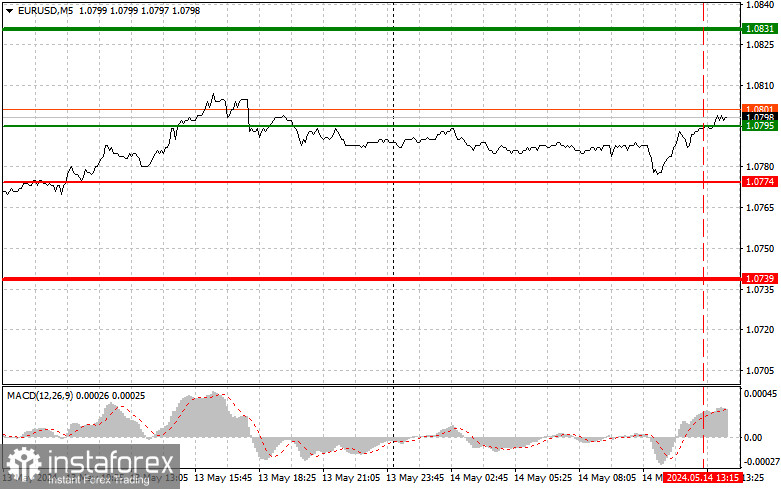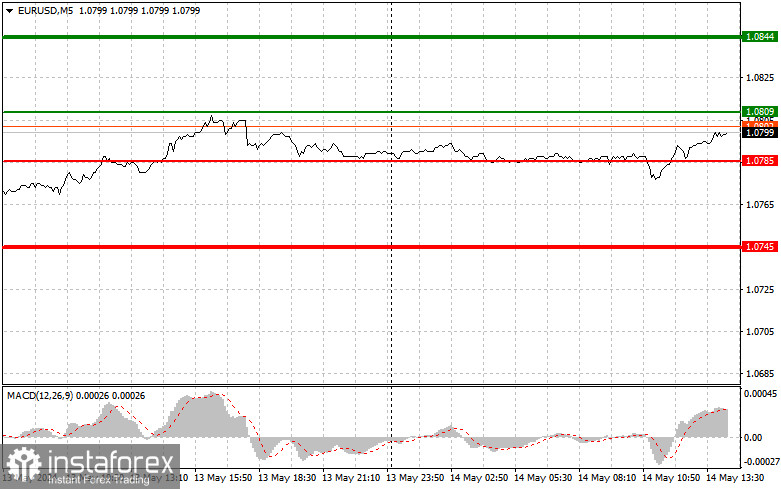Trade analysis and advice on trading the euro
The test of the price at 1.0795 in the first half of the day occurred when the MACD indicator had risen significantly above the zero mark, limiting further upward potential. For this reason, I did not buy euros. There was no repeat test of this level to implement scenario #2. Fairly decent data from Germany and the rise in the ZEW Economic Sentiment Index for the Eurozone led to a new wave of risk asset strengthening, but it cannot be said that buyers gained any colossal advantage yet. The focus is on the American session, where another set of US inflation data will be released, and Federal Reserve Chairman Jerome Powell will speak. The words and statements of the policymaker will carry much more weight than producer price data, so I will focus on them. A tough approach to fighting inflation will further delay traders' expectations for rate cuts, leading to demand for the dollar and a decline in the euro. Conversely, an unlikely situation would allow the euro to continue rising. As for the intraday strategy, I plan to act based on the realization of scenarios #1 and #2.

Buy Signal
Scenario #1: Today, I plan to buy euros when the price reaches around 1.0809 (green line on the chart), with a target of rising to 1.0844. At 1.0844, I will exit the market and sell euros in the opposite direction, aiming to move 30-35 points from the entry point. Euro growth can be expected today, but only after Powell's soft statements. Important! Before buying, ensure the MACD indicator is above the zero mark and just starting to rise from it.
Scenario #2: I also plan to buy euros today in case of two consecutive tests of the price at 1.0785 at a time when the MACD indicator is in the oversold zone. This will limit the downside potential of the pair and lead to a reversal of the market upwards. Expect growth to the opposite levels of 1.0809 and 1.0844.
Sell Signal
Scenario #1: I will sell euros after reaching 1.0785 (red line on the chart). The target will be the level of 1.0745, where I plan to exit the market and buy euros immediately in the opposite direction (expecting a movement of 20-25 points in the opposite direction from the level). Pressure on the pair will return in case of buyer inactivity around Fed representatives' daily high and hawkish statements. Important! Before selling, ensure the MACD indicator is below the zero mark and starting to decline.
Scenario #2: I also plan to sell euros today in case of two consecutive tests of the price at 1.0809 at a time when the MACD indicator is in the overbought zone. This will limit the upside potential of the pair and lead to a downward market reversal. Expect a decline to the opposite levels of 1.0785 and 1.0745.

On the Chart:
Thin green line - entry price, at which the trading instrument can be bought.
Thick green line - the assumed price where you can place Take Profit or manually take profits, as further growth above this level is unlikely.
Thin red line - entry price, at which the trading instrument can be sold.
Thick red line - the assumed price where you can place Take Profit or manually take profits, as further decline below this level is unlikely.
MACD indicator. When entering the market, following the overbought and oversold zones is important.
Important. Beginner traders in the forex market need to be very cautious when making decisions to enter the market. It's best to stay out of the market before important fundamental reports are released to avoid being caught in sharp exchange rate fluctuations. If you decide to trade during news releases, always place stop orders to minimize losses. You can quickly lose your deposit without placing stop orders, especially if you do not use money management and trade with large volumes.
And remember, for successful trading, you need to have a clear trading plan, like the one presented above. Spontaneous trading decisions based on the current market situation are initially a losing strategy for an intraday trader.





















